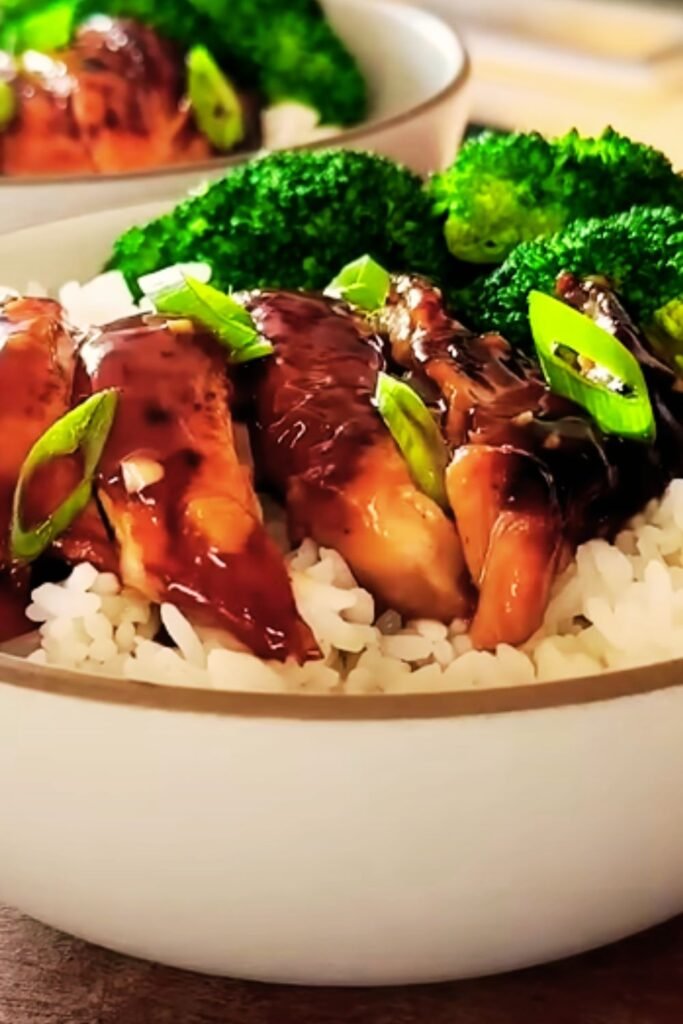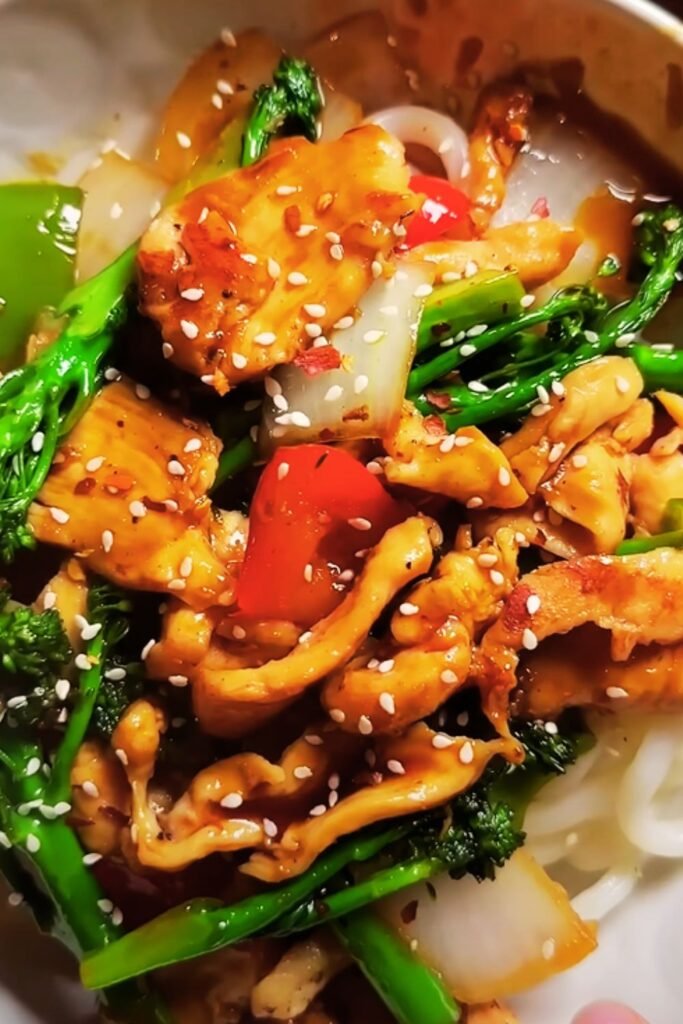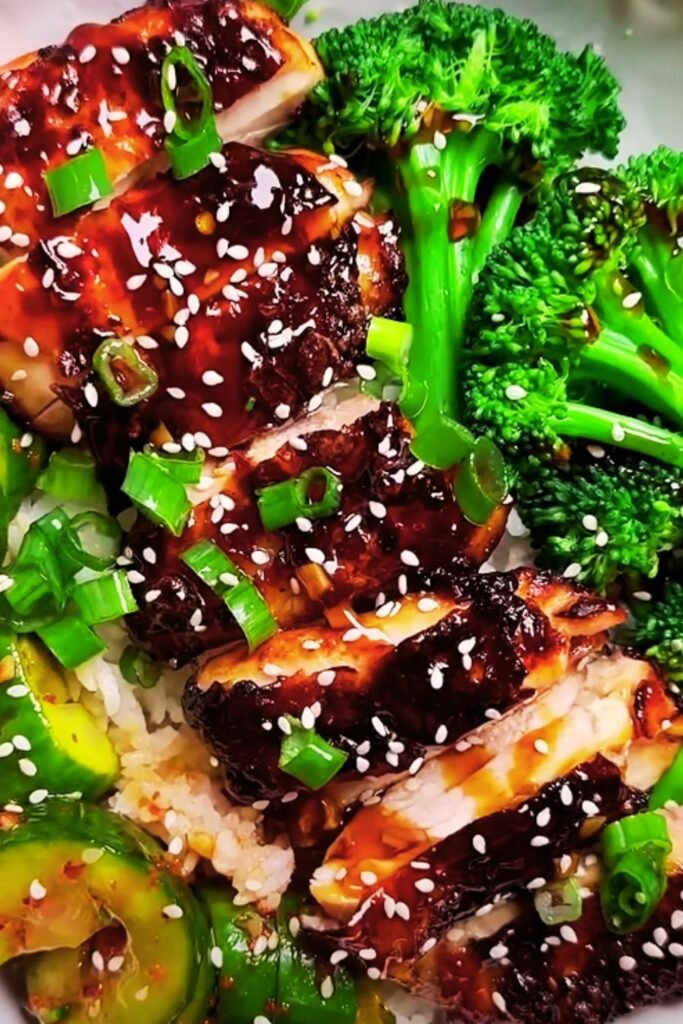When I first started cooking for my family, I was constantly searching for meals that could satisfy everyone while being quick enough to prepare after a long day. That’s when I discovered the magic of teriyaki chicken stir fry. This dish has become my absolute lifesaver – it’s packed with flavor, loaded with nutrients, and comes together in just 20 minutes. Over the years, I’ve perfected my technique and discovered countless variations that keep this meal exciting.
The beauty of teriyaki chicken stir fry lies in its perfect balance of sweet and savory flavors, combined with the satisfying crunch of fresh vegetables. What makes this dish particularly special to me is how it brings together the umami-rich teriyaki sauce with tender chicken pieces and colorful vegetables, creating a meal that’s both visually appealing and incredibly delicious. I’ve served this to countless dinner guests, and it never fails to impress.
Understanding Teriyaki: The Foundation of Flavor
Teriyaki sauce: A Japanese cooking technique and sauce that combines soy sauce, mirin, and sugar to create a glossy, caramelized coating on proteins and vegetables.
Mirin: A sweet Japanese rice wine with lower alcohol content than sake, essential for authentic teriyaki flavor and providing the characteristic glossy finish.
Umami: Often called the fifth taste, this savory flavor profile comes from ingredients like soy sauce and adds depth to the dish.
Stir-frying: A cooking method that uses high heat and constant movement to quickly cook ingredients while maintaining their texture and nutritional value.
The teriyaki sauce I use in my recipe is a carefully balanced blend that I’ve refined over years of experimentation. Unlike store-bought versions that can be overly sweet or loaded with preservatives, my homemade sauce allows me to control the sweetness level and sodium content while ensuring fresh, vibrant flavors.
Essential Ingredients and Their Roles
When I prepare teriyaki chicken stir fry, I always start with the highest quality ingredients I can find. The chicken breast should be fresh and preferably organic, as it provides the best texture and flavor. I’ve learned that the key to tender chicken is proper preparation – cutting against the grain and marinating briefly makes all the difference.
Primary Ingredients Table
| Ingredient | Quantity | Purpose | Substitutions |
|---|---|---|---|
| Chicken breast | 1.5 lbs | Protein base | Chicken thighs, tofu, shrimp |
| Soy sauce | 1/3 cup | Umami foundation | Tamari, coconut aminos |
| Mirin | 3 tbsp | Sweetness and gloss | Rice vinegar + sugar |
| Brown sugar | 2 tbsp | Caramelization | Honey, maple syrup |
| Fresh ginger | 2 tbsp minced | Aromatic heat | Ground ginger (1 tsp) |
| Garlic | 4 cloves | Flavor enhancer | Garlic powder (1 tsp) |
| Cornstarch | 2 tbsp | Thickening agent | Arrowroot powder |
| Vegetable oil | 2 tbsp | Cooking medium | Sesame oil, avocado oil |
Vegetable Selection Guide
| Vegetable | Preparation | Cooking Time | Nutritional Benefit |
|---|---|---|---|
| Bell peppers | Sliced strips | 3-4 minutes | Vitamin C, antioxidants |
| Broccoli florets | Cut uniformly | 4-5 minutes | Vitamin K, fiber |
| Snap peas | Trimmed | 2-3 minutes | Vitamin A, protein |
| Carrots | Julienned | 4-6 minutes | Beta-carotene, fiber |
| Mushrooms | Sliced | 3-4 minutes | B vitamins, potassium |
| Onions | Sliced | 3-5 minutes | Sulfur compounds, flavor |

My Step-by-Step Cooking Method
Preparation Phase
I always emphasize the importance of mise en place – having everything prepared before you start cooking. Stir-frying happens quickly, and there’s no time to chop vegetables once the wok gets hot.
Chicken preparation: I slice the chicken breast into uniform strips, approximately 1/4-inch thick. This ensures even cooking and prevents some pieces from becoming overcooked while others remain underdone.
Vegetable prep: All vegetables should be cut to similar sizes for consistent cooking. I arrange them in the order they’ll go into the pan, with harder vegetables like carrots and broccoli ready first.
Sauce mixing: I combine all sauce ingredients in a bowl and whisk until the cornstarch is completely dissolved. This prevents lumpy sauce and ensures smooth coating.
Cooking Process
- Heat the wok or large skillet over high heat until it’s smoking slightly
- Add oil and swirl to coat the entire surface
- Cook chicken in batches to avoid overcrowding (3-4 minutes per batch)
- Remove chicken and set aside on a plate
- Add harder vegetables first (carrots, broccoli) and stir-fry for 2-3 minutes
- Add softer vegetables (peppers, snap peas) and continue cooking
- Return chicken to the pan and toss everything together
- Pour sauce over the mixture and stir constantly until thickened
- Serve immediately over steamed rice

Advanced Techniques I’ve Learned
Temperature Control
The secret to perfect stir-fry lies in maintaining high heat throughout the cooking process. I’ve learned that if your pan isn’t hot enough, the ingredients will steam rather than sear, resulting in soggy vegetables and tough chicken. My wok should be hot enough that a drop of water sizzles and evaporates immediately.
Timing and Sequencing
Over the years, I’ve developed a precise timing system for adding ingredients. Proteins always go first to develop that beautiful caramelization, followed by vegetables in order of their cooking requirements. This method ensures everything finishes cooking simultaneously.
Sauce Application
I never add the sauce until the very end of cooking. This prevents the sugars from burning and allows the cornstarch to thicken properly without becoming gummy. The sauce should coat everything evenly and create that signature glossy appearance.
Nutritional Benefits and Health Considerations
Macronutrient Breakdown (Per Serving)
| Nutrient | Amount | Daily Value % |
|---|---|---|
| Calories | 285 | 14% |
| Protein | 28g | 56% |
| Carbohydrates | 18g | 6% |
| Fat | 12g | 18% |
| Fiber | 4g | 16% |
| Sodium | 890mg | 39% |
Health Benefits
The combination of lean protein from chicken and fiber-rich vegetables makes this dish incredibly nutritious. I particularly appreciate how the variety of colorful vegetables provides different vitamins and antioxidants. The broccoli contributes vitamin K and folate, while bell peppers add vitamin C and carotenoids.
For families watching their sodium intake, I recommend using low-sodium soy sauce and reducing the amount by half, then adding more ginger and garlic for flavor complexity. The dish can easily be made gluten-free by substituting tamari for regular soy sauce.
Variations I Love to Make
Protein Alternatives
Tofu Version: I press extra-firm tofu for at least 30 minutes, then cut into cubes and pan-fry until golden before adding the sauce.
Shrimp Adaptation: Medium shrimp cook in just 2-3 minutes, making this an even quicker meal option.
Beef Variation: Thinly sliced flank steak or sirloin works beautifully, though it requires slightly longer cooking time.
Seasonal Vegetable Swaps
Spring brings fresh asparagus and sugar snap peas, while summer offers zucchini and yellow squash. In autumn, I love adding butternut squash cubes (pre-roasted for better texture), and winter calls for heartier vegetables like Brussels sprouts and cauliflower.

Storage and Meal Prep Strategies
Refrigeration Guidelines
| Storage Method | Duration | Quality Notes |
|---|---|---|
| Refrigerated (sealed) | 3-4 days | Best texture within 2 days |
| Frozen portions | 2-3 months | Texture changes slightly |
| Sauce separately | 1 week | Better texture when reheated |
I’ve found that storing the components separately maintains better texture. The chicken and vegetables can be refrigerated together, while I keep extra sauce in a small container for reheating.
Reheating Techniques
The microwave works for convenience, but I prefer reheating in a skillet over medium heat with a splash of water or broth. This method helps restore some of the original texture and prevents the dish from becoming mushy.
Serving Suggestions and Pairings
Rice Varieties That Work Best
Jasmine rice: My personal favorite for its fragrant aroma and slightly sticky texture Brown rice: Adds nuttiness and extra fiber Cauliflower rice: Perfect for low-carb diets Quinoa: Provides complete protein and interesting texture
Complementary Side Dishes
I often serve this with simple steamed edamame or a cucumber salad dressed with rice vinegar and sesame oil. Miso soup makes an excellent starter, and fresh fruit like sliced mango or pineapple provides a refreshing finish.
Garnish Options
Fresh cilantro, sliced green onions, and sesame seeds add both visual appeal and flavor enhancement. I sometimes add a sprinkle of red pepper flakes for those who enjoy heat.
Troubleshooting Common Issues
Sauce Problems
Too thick: Add warm water or chicken broth one tablespoon at a time Too thin: Mix additional cornstarch with cold water and stir in gradually Too salty: Balance with a touch of sugar or rice vinegar Lacks depth: Add more ginger, garlic, or a splash of sesame oil
Cooking Challenges
Overcooked vegetables: Reduce cooking time and ensure higher heat Tough chicken: Cut against the grain and don’t overcook Uneven cooking: Cut ingredients uniformly and don’t overcrowd the pan Soggy texture: Increase heat and ensure pan is properly preheated
Equipment Recommendations
While you can make stir-fry in any large pan, I strongly recommend investing in a carbon steel wok or heavy-bottomed stainless steel pan. The high heat retention and quick heat distribution make a significant difference in achieving that perfect sear.
A sharp knife is essential for efficient prep work, and I use my trusty 8-inch chef’s knife for everything from slicing chicken to chopping vegetables. A wooden spoon or wok spatula helps prevent scratching non-stick surfaces while providing good control during stirring.
Cultural Context and Origins
Teriyaki, literally meaning “glaze-grilled” in Japanese, originated as a cooking technique rather than just a sauce. Traditional teriyaki involved grilling fish with this sweet-savory glaze, but the technique has evolved beautifully into stir-fry applications. My version respects the traditional flavor profile while adapting it for modern home cooking convenience.
Cost Analysis and Budget Tips
Ingredient Cost Breakdown
| Ingredient Category | Cost per Serving | Budget Tips |
|---|---|---|
| Chicken breast | $2.50 | Buy in bulk, freeze portions |
| Vegetables | $1.25 | Use seasonal, frozen alternatives |
| Sauce ingredients | $0.75 | Make large batches, store extras |
| Rice/grains | $0.50 | Buy in bulk, store properly |
| Total per serving | $5.00 | Serves 4-6 people |
This meal costs significantly less than takeout while providing better nutrition and flavor control. I often double the recipe and use leftovers for lunch bowls throughout the week.
Questions and Answers
Q: Can I make the sauce ahead of time?
Absolutely! I prepare large batches of teriyaki sauce and store them in the refrigerator for up to two weeks. Just whisk it before using since the cornstarch may settle. This makes weeknight cooking even faster.
Q: What’s the best way to prevent the chicken from sticking to the pan?
Make sure your pan is properly heated before adding oil, and don’t move the chicken pieces immediately after adding them. Let them develop a golden crust first – they’ll naturally release from the pan when ready to flip.
Q: Can I use frozen vegetables instead of fresh ones?
Yes, but I recommend thawing and patting them dry first. Frozen vegetables contain more water, which can make your stir-fry soggy. Add them during the last few minutes of cooking to maintain some texture.
Q: How do I know when the sauce has thickened enough?
The sauce should coat the back of a spoon and cling to the ingredients without being gloppy. It typically takes 1-2 minutes of constant stirring over high heat after adding the sauce mixture.
Q: Is there a way to make this dish spicier without changing the flavor profile too much?
I add red pepper flakes to the oil before cooking the chicken, or incorporate sriracha into the sauce. Start with small amounts since you can always add more heat, but you can’t take it away.
Q: Can I substitute the brown sugar with a healthier alternative?
Honey works wonderfully and adds complex flavor notes. Maple syrup is another excellent option. Coconut sugar provides similar caramelization properties with a slightly lower glycemic index.
Q: What’s the secret to getting restaurant-quality flavor at home?
High heat, proper timing, and not overcrowding the pan are crucial. I also recommend tasting and adjusting the sauce before adding it – sometimes it needs an extra splash of soy sauce or a pinch more sugar depending on your ingredients.
Q: How can I make this dish more filling without adding more calories?
I bulk up the vegetable content and serve it over cauliflower rice or shirataki noodles. Adding more broccoli, cabbage, or mushrooms increases volume and fiber without significantly increasing calories.
This teriyaki chicken stir fry has become more than just a recipe in my kitchen – it’s a reliable foundation that I build upon depending on what’s in season, what’s in my refrigerator, or what my family is craving. The technique translates to countless other flavor combinations, making it an invaluable skill for any home cook. Whether you’re cooking for picky eaters or adventurous food lovers, this dish delivers satisfaction every single time.